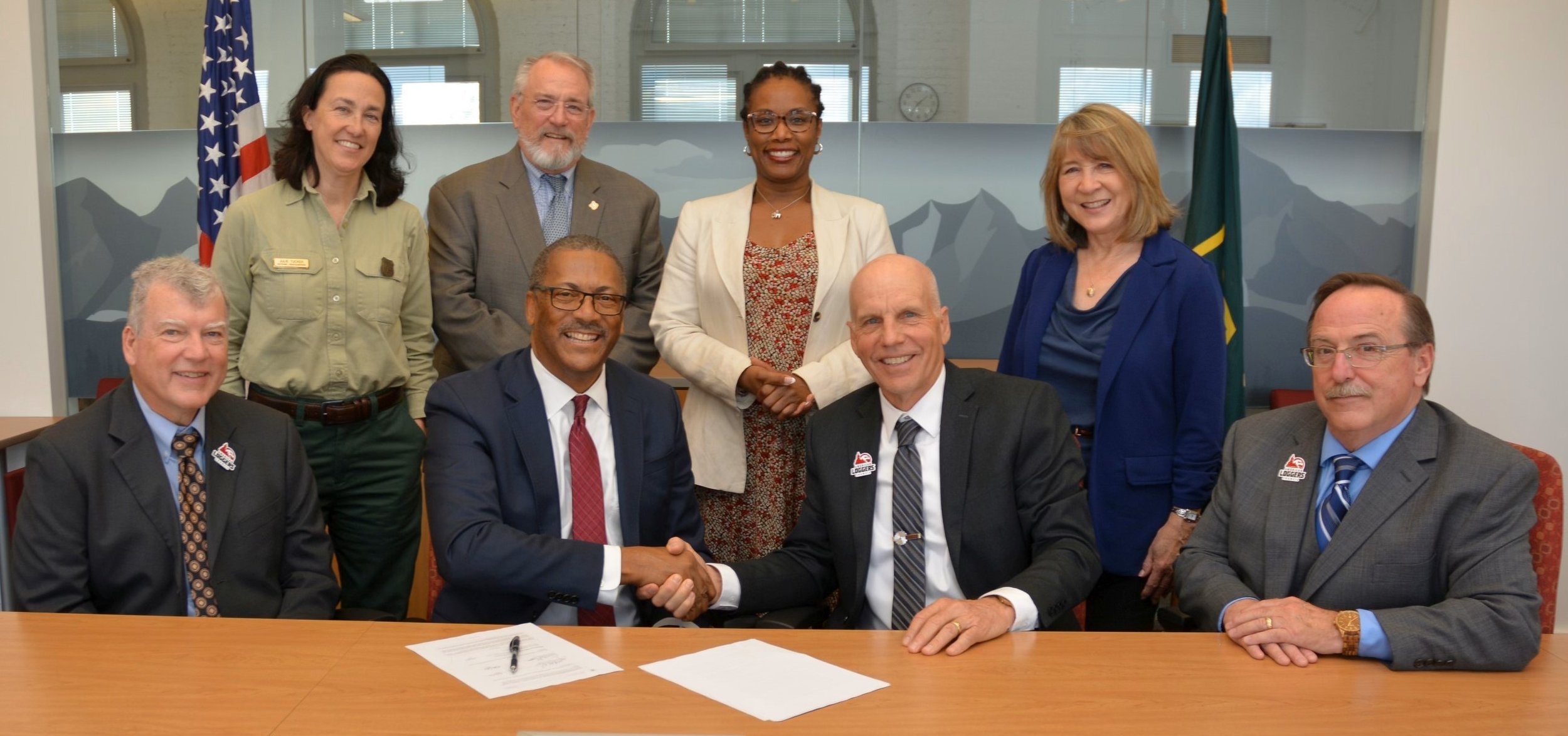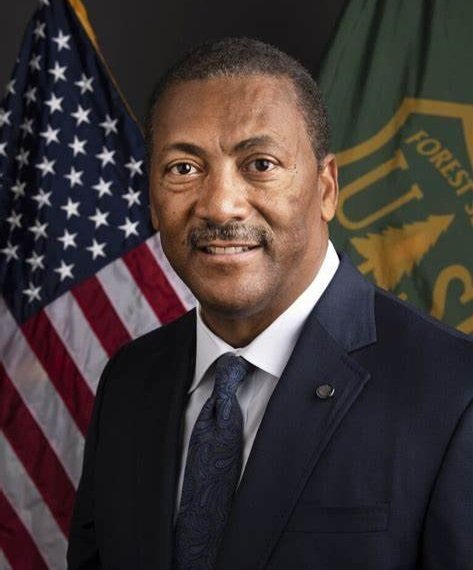With over 50 mill closures over the past 14 months and other challenging factors, the American Loggers Council was pleased to assist with securing the USFS Substantial Overriding Public Interest (SOPI) declaration that allows for rate redeterminations and extensions on USFS timber contracts that meet certain criteria.
DEPARTMENT OF AGRICULTURE
Forest Service
Extension of Certain Timber Sale Contracts; Finding of Substantial Overriding Public Interest
AGENCY: Forest Service, Agriculture (USDA)
ACTION: Notice of rate redeterminations and contract extensions.
SUMMARY: The Chief of the Forest Service, Department of Agriculture, has determined that it is in the substantial overriding public interest (SOPI) to redetermine pulpwood rates and extend up to two years certain National Forest System timber sales and sale of property stewardship contracts. This finding applies to timber sale and sale of property stewardship contracts that were awarded before March 13, 2024, and, upon award, to contracts with a bid opening prior to March 13, 2024, subject to specified exceptions. Contracts with 20 percent or more of the included product listed as pulpwood with required removal will qualify for a pulpwood rate redetermination and may qualify for an extension under this SOPI finding. The SOPI determination is due to a combination of factors impacting the national economy and the pulp, paper, and chips markets. The intended effect of pulpwood rate redeterminations and extensions of certain timber and sale of property contracts is to allow timber purchasers and contractors time to navigate through the market conditions; to minimize contract defaults, mill closures, and bankruptcies; to sustain employment opportunities, and to minimize the time-consuming and often difficult process of collecting default damages. Without a vibrant forest products industry, the Forest Service cannot manage the land to meet the multiple forest management and restoration objectives nationwide as intended and funded by Congress.
DATES: The SOPI determination was made on March 8, 2024, by the Chief of the Forest Service, Department of Agriculture.
FOR FURTHER INFORMATION CONTACT: Kraig Kidwell, Contracts and Appraisals Group Lead, at 541-961-2614 or by email at kraig.kidwell@usda.gov, or Mike Spisak, Assistant Director Forest Management, at 910-975-0114 or by email at michael.spisak@usda.gov; 1400 Independence Ave. SW., Mailstop 1103, Washington, DC 20250-1103. Individuals who use telecommunications devices for the hearing impaired may call 711 to reach the Telecommunications Relay Service, 24 hours a day, every day of the year, including holidays.
SUPPLEMENTARY INFORMATION: The Forest Service sells timber and forest products from National Forest System lands to individuals and companies pursuant to the National Forest Management Act of 1976, 16 U.S.C. 472a (NFMA); the Stewardship End Result Contracting Projects Act, 16 U.S.C. 6591c; and implementing regulations in 36 CFR Part 223. Each sale is formalized by execution of a contract for the sale of property between the timber purchaser or stewardship contractor and the Forest Service. The contract sets forth the terms of the sale including such matters as the estimated volume of timber to be removed, the period for removal, price to be paid to the Government, and road construction and logging requirements. The average sale of property contract period is approximately 3 to 4 years, although some contracts have terms up to 10 years. The contract term is established by the Forest Service based on the estimated time an average prudent timber contractor would need to mobilize and complete the timber harvest under the conditions of the contract. Paragraph 14(c) of NFMA (16 U.S.C. 472a(c)) provides that the Secretary of Agriculture shall not extend any timber sale contract period with an original term of 2 years or more unless the Secretary finds that the purchaser has diligently performed in accordance with an approved plan of operations, or that the ‘‘substantial overriding public interest’’ justifies the extension. This authority is delegated to the Chief of the Forest Service through Forest Service Manuals 2404.11 and 2453.17, referencing 36 CFR 223.32, and 36 CFR 223.31.
Background
When members of the timber industry must decide whether to harvest timber during severely depressed markets and times of high inflation, or risk defaulting contracts, such decisions can and have led to bankruptcies, loss of infrastructure, and loss of jobs. This adversely affects stability in rural communities and the future management of National Forests as important opportunities and outlets for material disposal are lost. Providing additional contract time during significant market downturns allows timber purchasers additional flexibility to navigate the crisis and sustain long-term business viability.
On December 7, 1990, the Forest Service published a final rule (55 FR 50643) establishing procedures in 36 CFR 223.52 for extending contract termination dates in response to adverse conditions in timber markets. These procedures, known as Market Related Contract Term Additions (MRCTA), authorize extensions of timber contracts when qualifying market conditions are met. Subsequent amendments have provided that the total contract term may be extended up to 10 years as the result of MRCTA when specified criteria are met. When the MRCTA procedures were established, experience indicated that the type and magnitude of lumber market declines that would trigger market related contract term additions generally coincide with low numbers of housing starts and substantial economic dislocation in the wood products industry. MRCTA procedures were adopted by the Forest Service to avert contract defaults, mill closures, and associated impacts to dependent communities when there is a drastic decline in wood product prices (36 CFR 223.52).
In promulgating the MRCTA rule, the Department determined that a drastic reduction in wood product prices can result in a substantial overriding public interest sufficient to justify a contract term extension for existing contracts, as authorized by NFMA (16 U.S.C. 472a(c)) and existing regulations at 36 CFR 223.115(b). Most Forest Service timber sale contracts over 1-year in length include MRCTA procedures. Salvage sales and sales of products not covered in a Bureau of Labor Statistics producer price index (PPI) used to determine when MRCTA triggers are examples of contracts that do not include a MRCTA provision.
Market Conditions
The U.S. pulp and paper industry accounts for upwards of 30 percent of the global pulp and paper production (https://www.fortunebusinessinsights.com/north-america-pulp-and-paper-market-106617), producing 46.66 million metric tons of pulp for paper in 2022 (https://www.statista.com/statistics/1276346/annual-pulp-production-united-states/). Globally, consumption of pulp for paper has tripled since the 1960s with 197.17 million metric tons of consumption in 2022, although several notable drops in consumption having occurred and recovered through this period (https://www.statista.com/statistics/1177457/consumption-of-pulp-worldwide/). There is a corresponding increase in the global consumption of paper and paperboard, estimated at 414.19 million metric tons and almost a 75 percent increase from 1990 levels (https://www.statista.com/statistics/270319/consumption-of-paper-and-cardboard-since-2006/). Although global consumption has increased, domestically the long-term trends show a 30 percent decline in use of paper and paperboard since 2000, with consumption dropping from 93.4 million metric tons to 65.76 million metric tons in 2022 (https://www.statista.com/statistics/252710/total-us-consumption-of-paper-and-board-since-2001/).
During the same period, the PCU3211133211135 producer price index (PPI) used to value pulp and paper has continued to trend upwards with only a few significant drops in the market that initiated market-related contract term additions or emergency rate redeterminations on Forest Service contracts, most recently during the 2009–2013 period. See PPI industry data for Sawmills-Wood chips, excluding field chips, not seasonally adjusted from the U.S. Bureau of Labor Statistics at https://data.bls.gov/cgi-bin/dsrv?pc. Following the COVID-19 pandemic, increases in paper use combined with the slow downsizing of the pulp and paper industry over time through mill closures and reductions in output have helped maintain the producer price index at high values. The preliminary January 2024 PCU3211133211135 producer price index from the U.S. Bureau of Labor Statistics is currently 143.926, down slightly from 20-year highs.
The three Bureau of Labor Statistics producer price indices the Forest Service currently uses to gauge most market conditions include Hardwood Lumber 0812, Softwood Lumber 0811, and Chips (not field chips) PCU3211133211135, per 36 CFR 223.52. However, these indices are not able to address all forest products and market conditions. For example, biomass material, which is a large component of many stewardship contracts, is not covered by these indices. Because the indices are national in scope, they may fail to address drastic declines in local markets or products and, more importantly at this time, local and regional markets affected by mill closures, raw material delivery quotas, and reductions in finished product outputs at facilities.
As one measure of the overall timber and forest products market, beginning in the fourth quarter of 2021, the Softwood Lumber producer price index declined enough for applicable contracts to qualify for relief under Market Related Contract Term Addition (MRCTA) provisions. This trend has continued, with contracts based in the Softwood Lumber PPI qualifying for MRCTA in 9 of the last 12 consecutive quarters. In addition, contracts based in the 0811 Softwood Lumber PPI and awarded in 19 of the previous 40 months have triggered for emergency rate redeterminations, with many contracts triggering more than once. A purchaser may apply for an emergency rate redetermination if the producer price index identified in the contract has declined by 25 percent since the award date or last rate redetermination.
A similar downward trend has occurred in the Hardwood Lumber PPI beginning in the second quarter of 2018, but contracts did not begin to qualify for MRCTA until September of 2022. Since then, the Hardwood Lumber PPI has qualified for MRCTA in six consecutive quarters. In addition to the MRCTA, the Hardwood Lumber PPI met the criteria for emergency rate redeterminations for nine consecutive months in late 2021 into 2022. The hardwood market has stabilized somewhat since and not triggered additional emergency rate redeterminations, although contracts are still qualifying for the MRCTA through the most recent calendar quarter.
The last qualifying quarter for MRCTA with the PCU3211133211135 producer price index was 2013 and the last qualifying month for an emergency rate redetermination was in 2012. Due to consistent reduction in domestic paper usage and an increase in recycling, pulp and paper producers appear to be “right sizing” with mill closures and output reductions to keep the market resilient. The recent mill closures, and delivery quotas due to the subsequent raw material supply surplus, appears to reflect the continuous decline in pulp and paper consumption over the past 20 plus years and accelerated by inflationary pressures. Paper mills that also have historically used large quantities of new pulp fiber are now sourcing more from cheaper recycled material and very low-cost mill residuals. As noted, the gradual downsizing of the industry combined with post-pandemic increases in packaging and shipping paper has helped maintain the producer price index and finished goods markets while reducing raw material intake. This SOPI will provide a rate redetermination to offset the post-pandemic inflation costs, provide time for qualifying purchasers and contractors whose operations are disrupted by mill closures and delivery quotas, and allow time for raw material supplies to stabilize.
Rate Redeterminations and Contract Extensions
Pursuant to this SOPI, and as discussed herein, contracts with 20 percent or more of the Included Timber in A(T)2 identified as “pulpwood” at award or included through modification or agreement and appraised with product codes 02, 08, and 14, will qualify for pulpwood rate redetermination and may qualify for an extension under this SOPI finding. Extensions will be granted upon written request of the contract holder, except under the following conditions: (1) the contract holder’s request includes timber and forest products in urgent need of removal due to forest health conditions or to mitigate a significant wildfire threat to a community, municipal watershed, or other critical public resource, or (2) included timber is designated by diameter and a delay in harvesting may change the treatment required under the contract because of trees growing into or outside of the specified diameter range(s). Contracts that are in breach will not qualify for relief until such breach is remedied. The percentage of included product and percentage of the contract completion is determined by the Forest Service as of the date the written request is received by the Contracting Officer. Relief will be provided to qualifying contracts in the manner described below.
Contracts that have removed 75 percent or more of all included volume. These contracts may receive a rate redetermination for the pulpwood product only. Rates will not be adjusted upward, only downward if a rate redetermination shows a decrease. Rates cannot be redetermined below base rates and base rates will not be adjusted. No additional time will be added to these contracts under this SOPI. Contract term extensions may be granted upon the written request of the purchaser and at the discretion of the Contracting Officer in contracts that contain provisions for contract term extension.
Contracts that have removed 50 percent or more and less than 75 percent of all included volume. These contracts may receive a rate redetermination for the pulpwood product only. Rates will not be adjusted upward, only downward if a rate redetermination shows a decrease. Rates cannot be redetermined below base rates and base rates will not be adjusted. Contract termination dates may be extended up to one year from the current termination date. Downpayment amounts will be recalculated, and periodic payments will be extended an equal amount of time. Timber sale contracts may be extended beyond the 10-year contract term limitation with this SOPI determination. Future Market Related Contract Term Additions may be granted following contract procedures, except that contracts will not qualify for Additions if they are extended beyond a 10-year contract term under the SOPI, pursuant to 36 CFR 223.52.
Contracts that have removed less than 50 percent of all included volume. These contracts may receive a rate redetermination for the pulpwood product only. Rates will not be adjusted upward, only downward if rate redetermination shows a decrease. Rates cannot be redetermined below base rates and base rates will not be adjusted. Contract termination dates may be extended up to two years from the current termination date. Downpayment amounts will be recalculated, and periodic payments will be extended an equal amount of time. Contracts can be extended beyond the 10-year contract term limitation with this SOPI determination. Future Market Related Contract Term Additions may be granted following contract procedures, except that contracts will not qualify for Additions if they are extended beyond a 10-year contract term under the SOPI, pursuant to 36 CFR 223.52.
Contracts that have received Diligent Performance Extensions in the previous 12 months will have the extension time granted under this SOPI, if any, reduced by the length of time granted for the Diligent Performance Extension. Integrated Resource Timber Contracts may require modification to mandatory stewardship projects if the rate redetermination reduces current contract value below that needed to pay for the projects. If the rate redetermination results in a deficit appraisal on the pulpwood product, the deficit will not be offset with positive value species and the rates for pulpwood will be base rates with no change to rates for positive value species.
Chief’s Determination of Substantial Overriding Public Interest
The Government benefits if timber contract defaults, mill closures, and bankruptcies can be avoided by granting rate redeterminations and extensions. The forest products industry is critical to addressing the wildfire crisis and meeting forest management and climate change objectives nationally, while supporting hundreds of thousands of meaningful jobs throughout the country. Having numerous economically viable timber purchasers increases competition for National Forest System timber contracts, results in higher prices paid for such timber, and allows the Forest Service to provide a continuous supply of timber to the public in accordance with the Organic Administration Act. In addition, by extending contracts and avoiding defaults, closures, and bankruptcies, the Government avoids the difficult, lengthy, expensive, and sometimes impossible process of collecting default damages.
By preventing defaults, better utilization of various forest resources (consistent with the provisions of the Multiple-Use Sustained-Yield Act of 1960) will result if contracts can be extended beyond 10 years because of this finding. Therefore, pursuant to 16 U.S.C. 472a(c), and subject to specific conditions and exceptions, I have determined that it is in the substantial overriding public interest to redetermine pulpwood rates and extend, up to two years, certain National Forest System timber sale and sale of property stewardship contracts that were awarded before March 13, 2024, or had a bid opening date prior to March 13, 2024, but have not yet been awarded.
Total contract length may exceed 10 years because of an extension under this SOPI determination. Downpayment amounts will be recalculated and any periodic payment due dates that have not been reached, as of the date the Contracting Officer receives a written request for a SOPI extension, shall be adjusted one day for each day of additional contract time granted.
To receive an extension and periodic payment deferral pursuant to this SOPI, purchasers must make a written request and agree to release the Forest Service from all claims and liability during the extension period if a contract extended pursuant to this finding is suspended, modified, or terminated in the future. The Forest Service shall continue to monitor market conditions to determine if additional relief measures may be needed in the future.
Randy Moore - Chief, Forest Service














